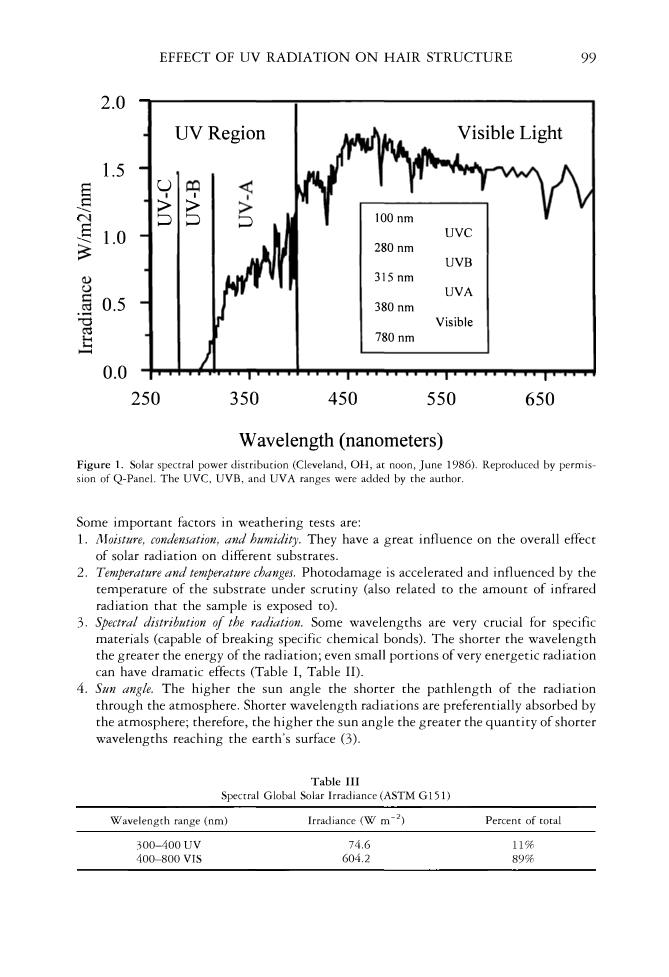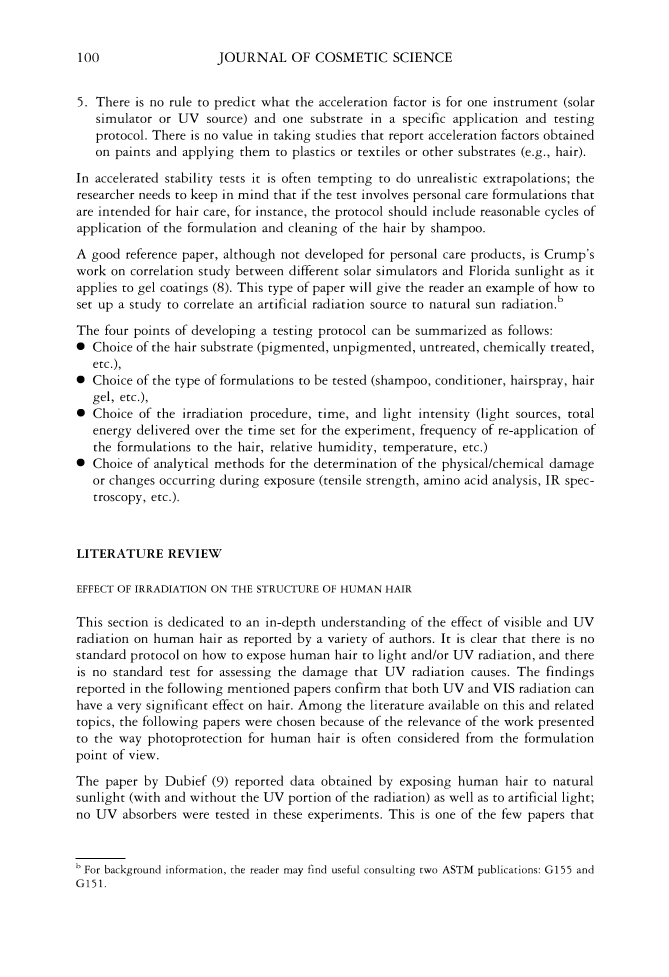EFFECT OF UV RADIATION ON HAIR STRUCTURE 99 2.0 UV Region Visible Light 1.5 s u I c:: -- � � s 1.0 -- 100 nm � uvc 280 nm UVB 315 nm 0.5 UVA 380 nm ·- Visible 780 nm 0.0 250 350 450 550 650 Wavelength (nanometers) Figure 1. Solar spectral power distribution (Cleveland, OH, at noon, June 1986). Reproduced by permis sion of Q-Panel. The UVC, UVB, and UVA ranges were added by the author. Some important factors in weathering tests are: l. Moisture) condensation) and humidity. They have a great influence on the overall effect of solar radiation on different substrates. 2. Temperature and temperature changes. Photodamage is accelerated and influenced by the temperature of the substrate under scrutiny (also related to the amount of infrared radiation that the sample is exposed to). 3. Spectral distribution of the radiation. Some wavelengths are very crucial for specific materials (capable of breaking specific chemical bonds). The shorter the wavelength the greater the energy of the radiation even small portions of very energetic radiation can have dramatic effects (Table I, Table II). 4. Sun angle. The higher the sun angle the shorter the pathlength of the radiation through the atmosphere. Shorter wavelength radiations are preferentially absorbed by the atmosphere therefore, the higher the sun angle the greater the quantity of shorter wavelengths reaching the earth's surface (3). Table III Spectral Global Solar Irradiance (ASTM G 151) Wavelength range (nm) 300-400 UV 400-800 VIS Irradiance (W m- 2 ) 74.6 604.2 Percent of total 11% 89%
100 JOURNAL OF COSMETIC SCIENCE 5. There is no rule to predict what the acceleration factor is for one instrument (solar simulator or UV source) and one substrate in a specific application and testing protocol. There is no value in taking studies that report acceleration factors obtained on paints and applying them to plastics or textiles or other substrates (e.g., hair). In accelerated stability tests it is often tempting to do unrealistic extrapolations the researcher needs to keep in mind that if the test involves personal care formulations that are intended for hair care, for instance, the protocol should include reasonable cycles of application of the formulation and cleaning of the hair by shampoo. A good reference paper, although not developed for personal care products, is Crump's work on correlation study between different solar simulators and Florida sunlight as it applies to gel coatings (8). This type of paper will give the reader an example of how to set up a study to correlate an artificial radiation source to natural sun radiation. 6 The four points of developing a testing protocol can be summarized as follows: • Choice of the hair substrate (pigmented, unpigmented, untreated, chemically treated, etc.), • Choice of the type of formulations to be tested (shampoo, conditioner, hairspray, hair gel, etc.), • Choice of the irradiation procedure, time, and light intensity (light sources, total energy delivered over the time set for the experiment, frequency of re-application of the formulations to the hair, relative humidity, temperature, etc.) • Choice of analytical methods for the determination of the physical/chemical damage or changes occurring during exposure (tensile strength, amino acid analysis, IR spec troscopy, etc.). LITERATURE REVIEW EFFECT OF IRRADIATION ON THE STRUCTURE OF HUMAN HAIR This section is dedicated to an in-depth understanding of the effect of visible and UV radiation on human hair as reported by a variety of authors. It is clear that there is no standard protocol on how to expose human hair to light and/or UV radiation, and there is no standard test for assessing the damage that UV radiation causes. The findings reported in the following mentioned papers confirm that both UV and VIS radiation can have a very significant effect on hair. Among the literature available on this and related topics, the following papers were chosen because of the relevance of the work presented to the way photoprotection for human hair is often considered from the formulation point of view. The paper by Dubief (9) reported data obtained by exposing human hair to natural sunlight (with and without the UV portion of the radiation) as well as to artificial light no UV absorbers were tested in these experiments. This is one of the few papers that 6 For background information, the reader may find useful consulting two ASTM publications: G 15 5 and G151.
Purchased for the exclusive use of nofirst nolast (unknown) From: SCC Media Library & Resource Center (library.scconline.org)





































































































































